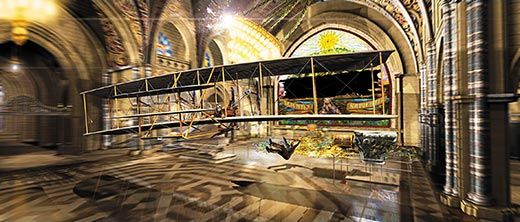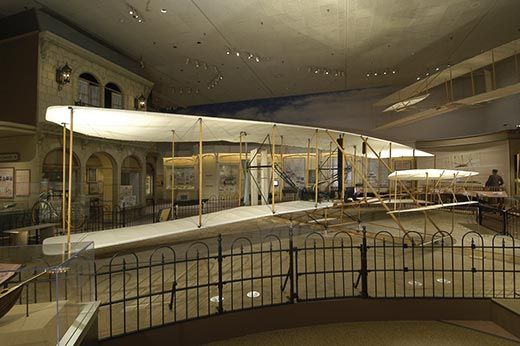Bringing the Wright Flyer to Life
In a movie first, curators and filmmakers collaborated to animate artifacts for Night at the Museum: Battle of the Smithsonian
/https://tf-cmsv2-smithsonianmag-media.s3.amazonaws.com/filer/wright-Flyer-631.jpg)
The Wright Flyer—perhaps the most famous airplane in the world—rests in a place of honor on the second floor of the National Air and Space Museum. In 1903, with Wilbur Wright at the controls, it flew at an altitude of ten feet in Kitty Hawk, North Carolina. More than a century later, museum curator Bob van der Linden watched in awe as the Flyer zoomed down the museum's upstairs hallway before diving over the balcony and soaring out of the building. "Here," he says, "is where you bite your lip and remember: this is a fantasy."
Van der Linden was getting a glimpse of an animated sequence from Night at the Museum: Battle of the Smithsonian (a sequel to 2006's Night at the Museum), in which artifacts and historical figures come to life. The movie, which opens nationwide May 22, reunites audiences with night watchman Larry Daley (Ben Stiller), who, in the new film, strikes up a romance with Amelia Earhart (Amy Adams).
"I was thrilled to see that the real Smithsonian was cooler than what it was in my head," says director Shawn Levy, whose film crew descended upon the National Mall for four days and nights in May 2008. He was especially enthralled by the gothic Castle—the Smithsonian Institution's original building, now an office complex and information center—which Levy reimagined as an evil fortress where a villainous Egyptian pharaoh (Hank Azaria) sits on a throne (Archie Bunker's chair) atop a pile of looted museum treasures.
Still, as befits a love story featuring America's most famous aviatrix, much of the action takes place at the Air and Space Museum, where curators are no strangers to movie crews—particularly documentary filmmakers, who sometimes have difficulty grasping the museum maxim look but don't touch. "We've had film crews who want to climb inside the airplanes or want to move the airplanes around," says Van der Linden. "Levy's crew did not. We were very pleased—and surprised."
The biggest surprises, though, would come a month later, after Levy and his creative team wrapped up their location filming in the nation's capital. Three thousand miles away, on a soundstage in Vancouver, Van der Linden and fellow curator Margaret Weitekamp found themselves standing within the museum's look-alike, painstakingly recreated by production designer Claude Paré. While in Washington, Paré had spent two weeks snapping some 2,000 reference photographs and taking notes that detailed everything from the objects on display to the number-coded shelving systems used by museum archivists. "I really sat down and said, ‘Oh my God, this is a huge undertaking,'" Paré says. "I was a little shaken."
When Weitekamp first visited the mock-up museum, she was greeted by a bizarre sight. "That man has a monkey on his head!" she exclaimed. The capucin monkey was a cast member playing Able—NASA's 1959 primate astronaut—and had climbed atop its handler. Paré then led the two curators on a tour of the set. "It was fascinating to see the liberties they took—pulling objects from all different parts of the museum and putting them all into one big room—and at the same time having a sense of fidelity to the museum itself," says Weitekamp. The fenestrated walls, which in the real museum expose the exhibits to sunlight, were replaced with walls designed to look like solid limestone. ("Which, actually, is a better way of making a museum, to be honest with you," says Van der Linden.) Paré and his design team even went so far as to impose 30 years' worth of simulated wear on the set's recreated brass handrails.
The two curators brought home no souvenirs, but the Institution will display one of the film's key props—the evil pharaoh's "pile of loot"—in the Castle through September. National Museum of American History curator of entertainment Dwight Blocker Bowers is both amused and horrified by the very idea of iconic artifacts—even reproductions of iconic artifacts—piled in a heap. But, like the other curators, he hopes the film will stimulate public interest in the Smithsonian and other museums. And, just possibly, he adds, "show that we have a sense of humor."

